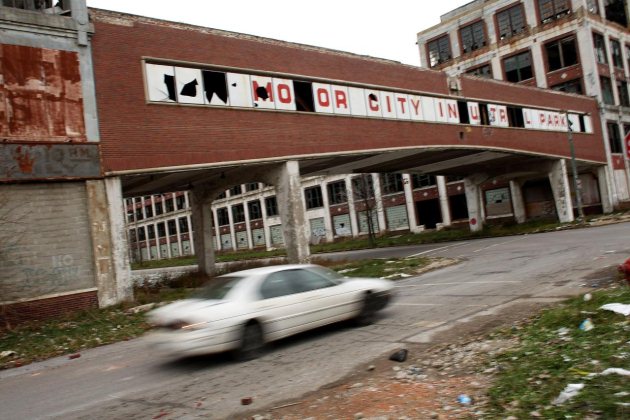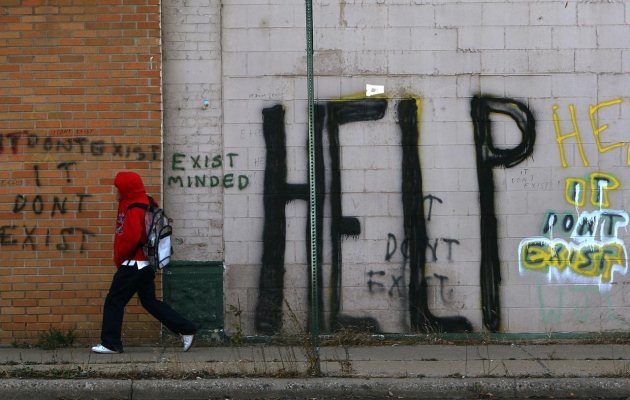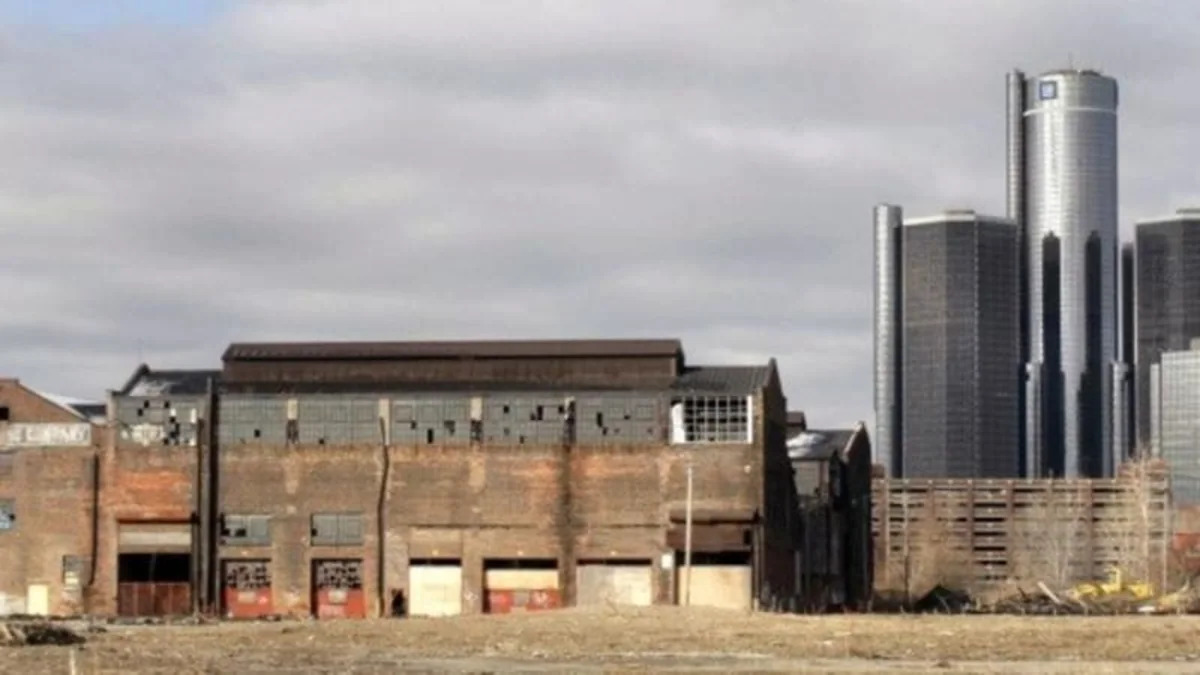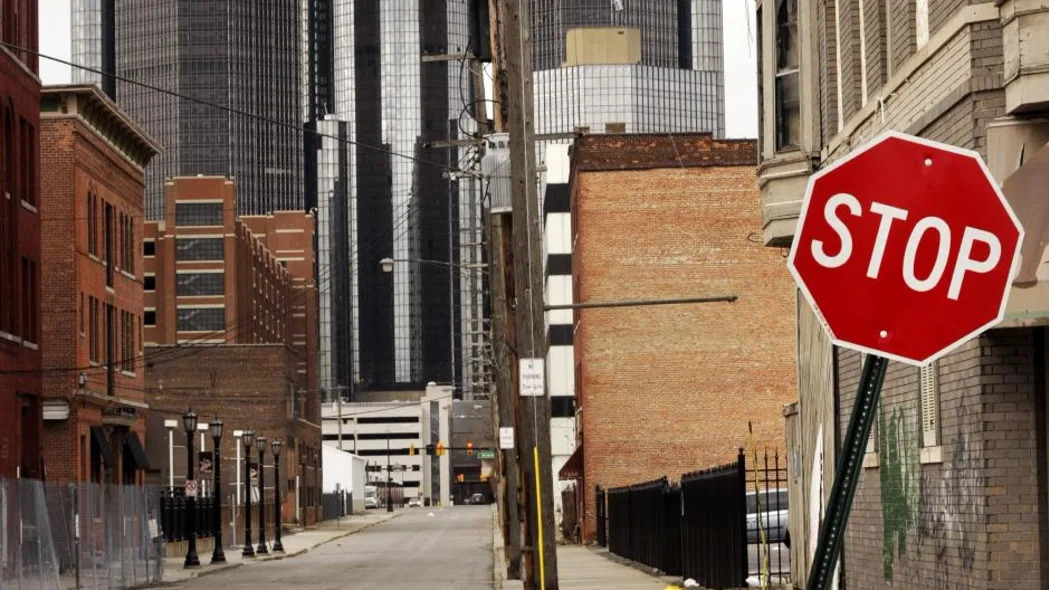GM headquarters stands tall behind ruins in Detroit – Click above for high-res image gallery
Once upon a time, Detroit was a city to be envied. Its inhabitants were highly-skilled workers that earned solid wages and lived in nice homes that made up good neighborhoods. So alluring was the promise of Detroit that the city grew sixfold throughout the first half of the previous century. In fact, at its peak in 1950, Detroit was the fourth largest city in the United States and looked to all the world as if its boundaries would do nothing but increase over the next few decades. Suffice it to say, this didn't happen.
Nearly a million people in the last 60 years have left the city, meaning that Detroit has literally thousands of empty office buildings, theaters, houses and hotels. In the once bustling Downtown area alone, there are more than 200 abandoned buildings on the National Register of Historic Places. Some of them can be seen in our high-res image gallery below. But how did it get this way, and is there no hope for The Motor City? Read on past the break for the rest of the story.
[Images: Getty]
It's no surprise that Detroit's rise and fall can also be plotted on a chart by the ebb and flow of American automobile manufacturers and suppliers. Today, there are three large automakers that operate on a global scale that are based in or around Detroit, Michigan. That's a far cry from how things used to be in the city. Nameplates like Packard and Hudson once grace many an automotive plant within the Detroit city limits, but all that's left of these great manufacturing sites are now piles of rubble and abandoned buildings in various states of disrepair.
Even the Big Three automakers, namely General Motors, Ford and Chrysler, are relics of their former selves. After 77 consecutive years as the largest automaker in the world, General Motors was passed up by Japan's Toyota in 2008. Similarly, Ford is now the third largest seller of automobiles in the United States, and Chrysler was recently passed for the number four position by Honda, also out of Japan. And we're all familiar with last summer's bankruptcies of both GM and Chrysler.

Sounds depressing, doesn't it? Such facts and figures, along with a helicopter ride over the derelict city, prompted well-known late night television news series Dateline to suggest that the City of Detroit looks like Sarajevo from the air. Check out a segment of video from that episode at the bottom of this post.
Perhaps, though, the death of one industry can lead to opportunities for others who are willing to take a chance on the once proud city.
One such upstart industry may very well be farming. Intriguingly, Michael Score, president of Hantz Farms, has a plan that's currently in action that would see Detroit rise up as one of the largest areas of urban farmland in the world. Sound like a fanciful idea with little shot at actually working?
"That's the beauty of being down and out," says Hantz. "You can actually open your mind to ideas that you would never otherwise embrace."
Looking beneath the surface, the idea seemingly has merit. To wit, some 40 of the city's 140 or so square miles can be counted as barren residential or commercial land. To put that into perspective, the entire city of Miami, Florida, doesn't account for 40 square miles. For those living on the other side of the U.S. map, that's also roughly the size of San Francisco, California.
There are other influential people, though, that would simply like to see the city shrink down to a more manageable size now that its population is less than half of what it once was.

One such person is current Detroit Mayor Dave Bing, who is banking on the fact that the city's population will decrease by a substantial margin with the latest census for 2010. Assuming things go the way Bing expects, the mayor has plans to reduce the number of city workers, transportation services and school districts. While that would mean Detroit would get less funding from the federal government, it would also allow the city to lower its expenses in dramatic fashion and allow it to focus on the best options for recovery.
"We've got to pick those core communities, those core neighborhoods" to sustain and preserve, he said at a recent public appearance. "That's something that's possible here in Detroit."
Detroit's long-declining automotive industry is showing signs of recovery as well. General Motors has paid back the federal loans it received to help it through the bankruptcy process five years ahead of schedule, Chrysler reported a much smaller loss than anticipated last quarter and Ford has seen its sales, market share and revenue improve dramatically over the last few months.
Says White House spokesman Robert Gibbs, "We're not out of the woods by any stretch of the imagination. We have seen improvement. I think it's testament to a lot of people's hard work."
While Gibbs was referring specifically to the American automotive industry, perhaps a similar sentiment could be cast towards the City of Detroit in general. It's clearly not yet out of the water, but with a little hard work, perhaps some of its long-lost luster can once again be regained.
%Video-1161%



Sign in to post
Please sign in to leave a comment.
Continue